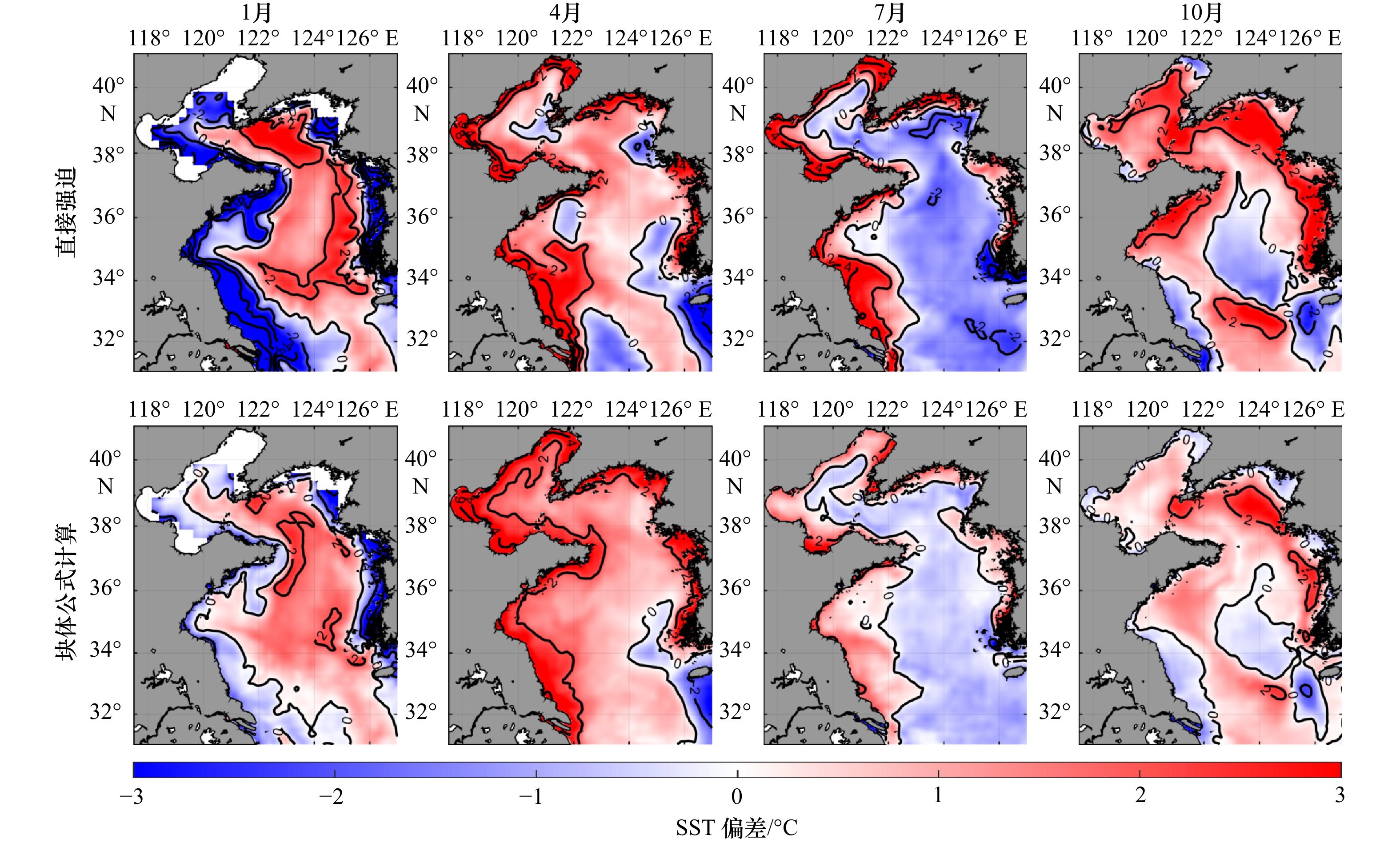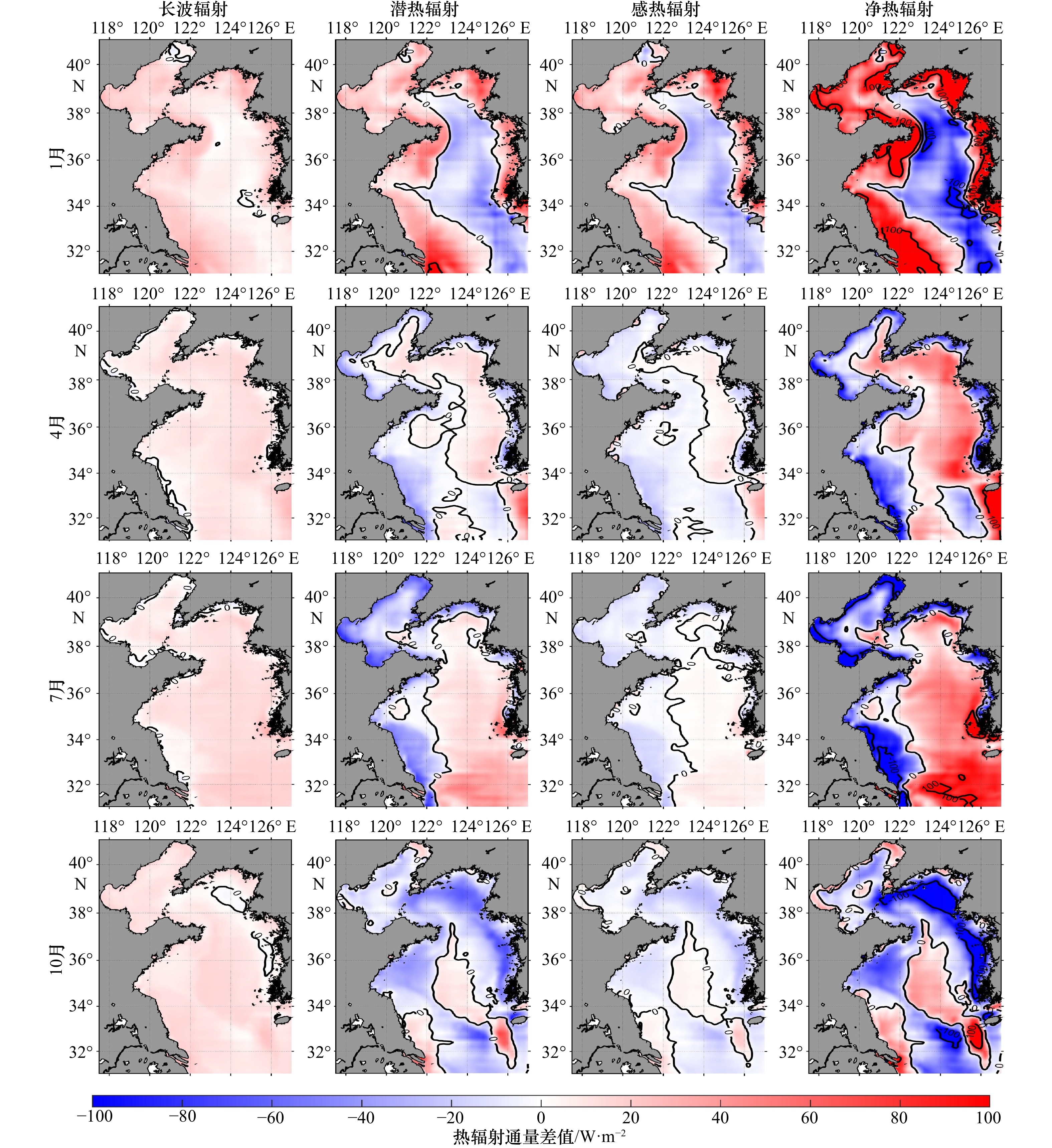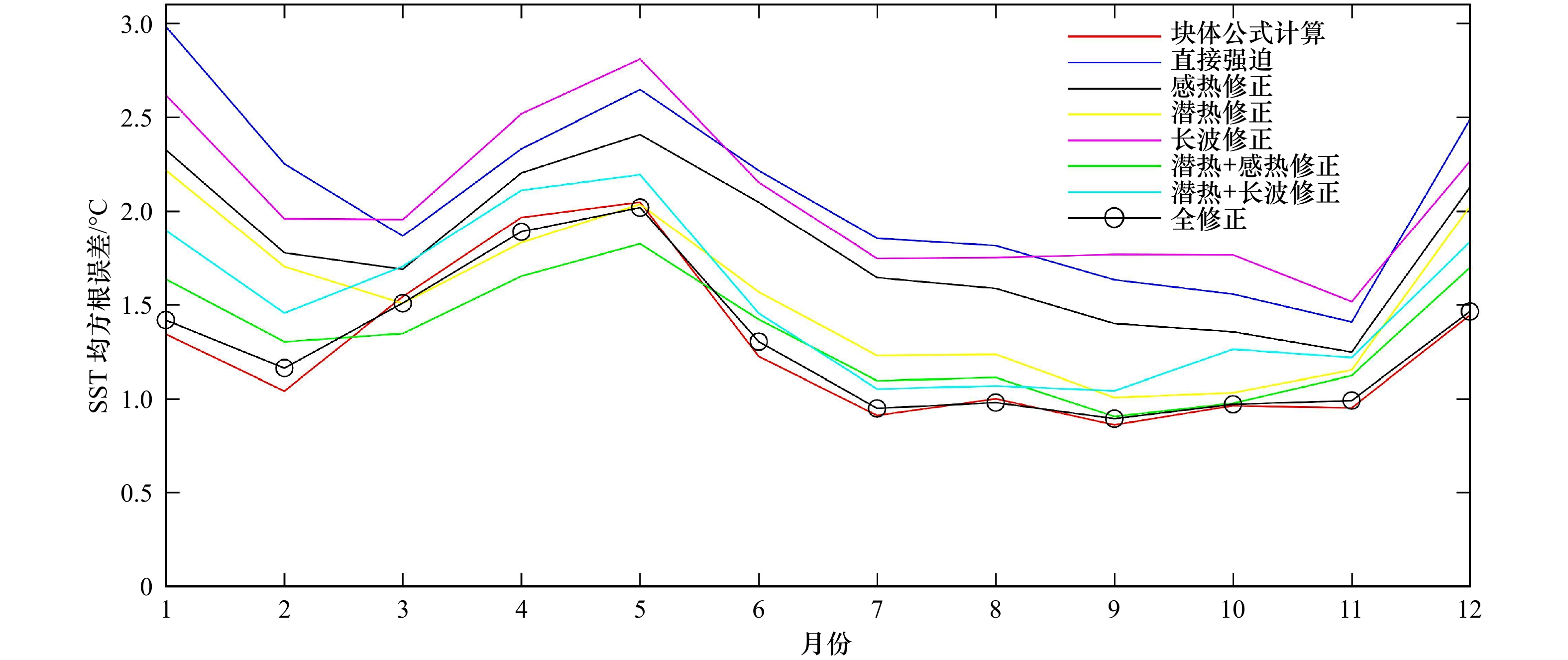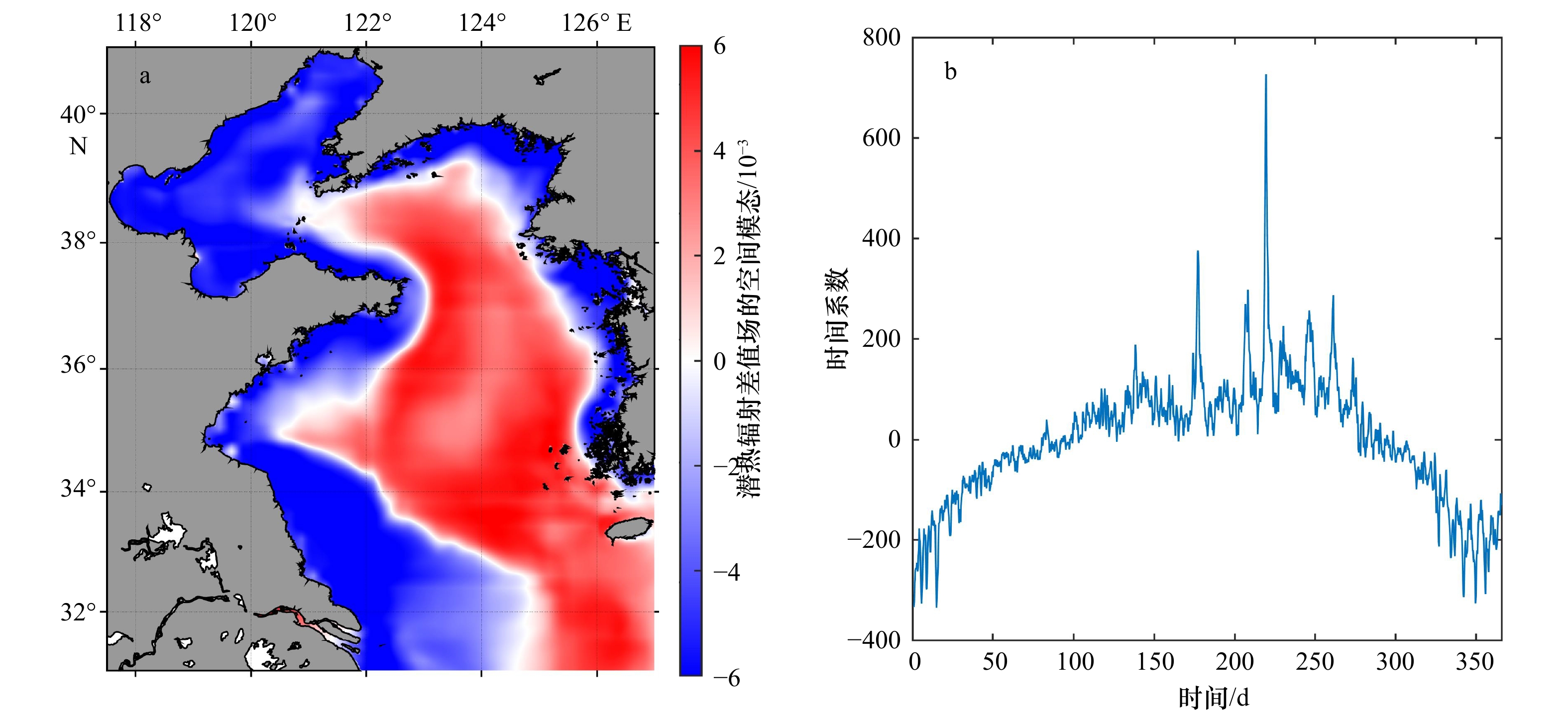A research on the optimal approach of CFSR surface flux data correction based on different surface forcing modes
-
摘要: 海表面温度(SST)的变化是海气相互作用的重要体现,SST的准确模拟也是海洋内部温度模拟的基础。基于区域海洋模式,本文通过对比分析两种强迫方式对SST的模拟效果,诊断了各辐射场对SST模拟效果的贡献,基于EOF分析法提出了一种针对CFSR表面大气强迫辐射数据的修正方案,并获取一套高频辐射场修正数据。数值对比试验结果显示,利用COARE 3.0公式计算所得表面强迫的方式模拟的SST结果更好,其均方根误差比直接强迫方式降低约39%;潜热辐射差异是两种强迫方式对SST模拟效果差异的主要原因,感热辐射差异次之,同时对两者进行修正可以显著改进SST的模拟效果;而长波辐射的修正则对冬季的SST模拟效果改善比较明显,但贡献仍弱于潜热辐射。相对于海洋模式而言,准确可靠的大气强迫数据的选择要优于强迫方式的选择。Abstract: Sea surface temperature (SST) is an important expression of air-sea interaction, and accurate simulation of SST is also the foundation of ocean internal temperature prediction. This paper attempts to diagnose the contribution of radiation fields on SST simulation by comparing the results of SST driven by two different surface forcing modes employing the Regional Ocean Model System (ROMS). According to the EOF analysis method, a correction scheme on CFSR surface atmospheric forcing radiation data is proposed, and therefrom, a high frequency revised dataset of CFSR radiation flux is obtained. The comparison tests show that surface forcing derived from the COARE 3.0 formula mode improves simulating performance of SST, as the RMSE decreases by 39% comparing to direct forcing mode. Comparing the thermal radiation fields of the two forcing modes, it is found that latent radiation is the main reason for different performances of SST simulation, and following by the effect of sensible heat radiation difference. Correction of both two radiation fields could improve the SST simulation results significantly; and correction of longwave radiation shows a more significant effect in winter which is still weaker than that of correction of latent radiation. In comprehensive, the accurate dataset of surface forcing field is more effective than change the choice of forcing mode.
-
Key words:
- sea surface temperature /
- CFSR /
- surface atmospheric forcing /
- heat flux correction
-
表 1 数值对比试验方案设置
Tab. 1 The scheme of numerical comparison experiments
强迫方式 辐射场计算 感热辐射 潜热辐射 长波辐射 试验1 块体公式计算 模式计算 模式计算 模式计算 试验2 直接强迫 直接提供 直接提供 直接提供 试验3 直接强迫 模式计算 直接提供 直接提供 试验4 直接强迫 直接提供 模式计算 直接提供 试验5 直接强迫 直接提供 直接提供 模式计算 试验6 直接强迫 模式计算 模式计算 直接提供 试验7 直接强迫 直接提供 模式计算 模式计算 试验8 直接强迫 模式计算 模式计算 模式计算 试验9 直接强迫 EOF修正 EOF修正 EOF修正 表 2 2011年辐射差值场EOF分析各模态的方差贡献
Tab. 2 Variance contributions of each mode of radiation difference by EOF analysis in 2011
感热辐射 潜热辐射 长波辐射 EOF1 37.6% 30.9% 33.8% EOF2 14.3% 23.0% 17.3% EOF3 9.5% 9.9% 12.0% EOF4 4.8% 5.6% 6.3% 前3模态方差贡献合计 61.4% 63.8% 63.1% -
[1] 鲍献文, 万修全, 高郭平, 等. 渤海、黄海、东海AVHRR海表温度场的季节变化特征[J]. 海洋学报, 2002, 24(5): 125−133. doi: 10.3321/j.issn:0253-4193.2002.05.015Bao Xianwen, Wan Xiuquan, Gao Guoping, et al. The characteristics of the seasonal variability of the sea surface temperature field in the Bohai Sea, the Huanghai Sea and the East China Sea from AVHRR data[J]. Haiyang Xuebao, 2002, 24(5): 125−133. doi: 10.3321/j.issn:0253-4193.2002.05.015 [2] 孟庆军. 黄海温度和环流对不同频率风场响应的数值模拟研究[D]. 青岛: 中国海洋大学, 2015.Meng Qingjun. A numerical study of the Yellow Sea temperature and circulation responses to different frequency wind[D]. Qingdao: Ocean University of China, 2015. [3] 周立佳, 党振中, 董慧超, 等. 气象强迫场时间频率对ROMS模式高分辨率数值模拟的影响分析[J]. 海洋技术学报, 2017, 36(2): 83−88.Zhou Lijia, Dang Zhenzhong, Dong Huichao, et al. Analysis on the effects of the climatological forcing frequency on high resolution simulation of ROMS[J]. Journal of Ocean Technology, 2017, 36(2): 83−88. [4] 王璐, 周天军, 刘海龙, 等. 两种热通量边界条件对热带太平洋海温模拟的影响[J]. 海洋学报, 2011, 33(4): 9−18.Wang Lu, Zhou Tianjun, Liu Hailong, et al. Comparison of two thermal forcing schemes in a global ocean model over tropical Pacific Ocean[J]. Haiyang Xuebao, 2011, 33(4): 9−18. [5] 黄艳松, 宋金宝. NCEP再分析资料和浮标观测资料计算海气热通量的比较[J]. 海洋科学, 2011, 35(12): 113−120.Huang Yansong, Song Jinbao. Comparison of air-sea heat fluxes calculated from national centers for enviromental prediction (NCEP) reanalysis data and moored buoy measurement data[J]. Marine Sciences, 2011, 35(12): 113−120. [6] 蒋国荣, 何金海, 吴咏明, 等. 海-气界面通量计算模式的敏感性试验研究[J]. 热带气象学报, 2004, 20(4): 346−354. doi: 10.3969/j.issn.1004-4965.2004.04.002Jiang Guorong, He Jinhai, Wu Yongming, et al. The sensitivity test study of air-sea surface flux model[J]. Journal of Tropical Meteorology, 2004, 20(4): 346−354. doi: 10.3969/j.issn.1004-4965.2004.04.002 [7] 肖斌, 乔方利, 吕连港. 南黄海海气热通量观测及其与OAflux数据集比较研究[J]. 海洋科学进展, 2013, 31(1): 43−54. doi: 10.3969/j.issn.1671-6647.2013.01.006Xiao Bin, Qiao Fangli, Lü Lian-gang. Observations of air-sea heat flux in the South Yellow Sea and their comparison with OAflux dataset[J]. Advances in Marine Science, 2013, 31(1): 43−54. doi: 10.3969/j.issn.1671-6647.2013.01.006 [8] 魏传杰, 于非, 吕连港, 等. 南黄海海面大气长波辐射计算方法的比较[J]. 海洋科学进展, 2009, 27(3): 302−311. doi: 10.3969/j.issn.1671-6647.2009.03.003Wei Chuanjie, Yu Fei, Lü Lian-gang, et al. Comparison among computational methods for atmospheric longwave radiation above sea surface in the Southern Yellow Sea[J]. Advances in Marine Science, 2009, 27(3): 302−311. doi: 10.3969/j.issn.1671-6647.2009.03.003 [9] Fairall C W, Bradley E F, Hare J E, et al. Bulk parameterization of air-sea fluxes: updates and verification for the COARE algorithm[J]. Journal of Climate, 2003, 16(4): 571−591. doi: 10.1175/1520-0442(2003)016<0571:BPOASF>2.0.CO;2 [10] 陈锦年, 伍玉梅, 何宜军. 中国近海海气界面热通量的反演[J]. 海洋学报, 2006, 28(4): 26−35. doi: 10.3321/j.issn:0253-4193.2006.04.004Chen Jinnian, Wu Yumei, He Yijun. The remote of the sensible and latent heat fluxes in China coast[J]. Haiyang Xuebao, 2006, 28(4): 26−35. doi: 10.3321/j.issn:0253-4193.2006.04.004 [11] 杨清华, 张蕴斐, 孙兰涛, 等. COARE算法估算海气界面热通量的个例对比分析[J]. 海洋预报, 2005, 22(4): 1−13. doi: 10.3969/j.issn.1003-0239.2005.04.001Yang Qinghua, Zhang Yunfei, Sun Lantao, et al. Comparative analyses on a case of the air-sea interface heat flux estimated by the COARE algorithm[J]. Marine Forecasts, 2005, 22(4): 1−13. doi: 10.3969/j.issn.1003-0239.2005.04.001 [12] Brunke M A, Fairall C W, Zeng X B, et al. Which bulk aerodynamic algorithms are least problematic in computing ocean surface turbulent fluxes?[J]. Journal of Climate, 2003, 16(4): 619−635. doi: 10.1175/1520-0442(2003)016<0619:WBAAAL>2.0.CO;2 [13] 马伟伟, 万修全, 万凯. 渤海冬季风生环流的年际变化特征及机制分析[J]. 海洋与湖沼, 2016, 47(2): 295−302.Ma Weiwei, Wan Xiuquan, Wan Kai. Interannual variation and formation of wind-driven currents of Bohai Sea in winter[J]. Oceanologia et Limnologia Sinica, 2016, 47(2): 295−302. [14] 张连新, 管长龙, 黄健. 海气热通量算法的改进及应用[J]. 中国海洋大学学报: 自然科学版, 2011, 41(12): 8−16.Zhang Lianxin, Guan Changlong, Huang Jian. Improvement to the air-sea heat flux algorithm and its application[J]. Periodical of Ocean University of China, 2011, 41(12): 8−16. [15] Wang Hui. Operational oceanography forecasting system in developing countries[R]. Washington, USA: GODAE OceanView Symposium, 2013. [16] Kourafalou V H, De Mey P, Le Hénaff M, et al. Coastal Ocean Forecasting: system integration and evaluation[J]. Journal of Operational Oceanography, 2015, 8(S1): s127−s146. doi: 10.1080/1755876X.2015.1022336 [17] Song Y H, Haidvogel D. A semi-implicit ocean circulation model using a generalized topography-following coordinate system[J]. Journal of Computational Physics, 1994, 115(1): 228−244. doi: 10.1006/jcph.1994.1189 [18] Mellor G L, Yamada T. Development of a turbulence closure model for geophysical fluid problems[J]. Reviews of Geophysics, 1982, 20(4): 851−875. doi: 10.1029/RG020i004p00851 [19] Ji Qiyan, Zhu Xueming, Wang Hui, et al. Assimilating operational SST and sea ice analysis data into an operational circulation model for the coastal seas of China[J]. Acta Oceanologica Sinica, 2015, 34(7): 54−64. doi: 10.1007/s13131-015-0691-y [20] Saha S, Moorthi S, Pan H, et al. NCEP climate forecast system reanalysis (CFSR) selected hourly time-series products, January 1979 to December 2010[R]. Boulder, CO: Research Data Archive at the National Center for Atmospheric Research, Computational and Information Systems Laboratory, 2010. [21] 史珍, 李响, 刘娜. 不同时间频次的外强迫对全球大洋海温模拟的影响[J]. 海洋预报, 2016, 33(6): 1−9. doi: 10.11737/j.issn.1003-0239.2016.06.001Shi Zhen, Li Xiang, Liu Na. Effects of different temporal resolution of wind and thermal forcing on simulated global ocean temperature[J]. Marine Forecasts, 2016, 33(6): 1−9. doi: 10.11737/j.issn.1003-0239.2016.06.001 [22] Mo Dongxue, Hou Yijun, Li Jian, et al. Study on the storm surges induced by cold waves in the Northern East China Sea[J]. Journal of Marine Systems, 2016, 160: 26−39. doi: 10.1016/j.jmarsys.2016.04.002 [23] 李云, 刘钦政, 张建华, 等. 最优插值方法在西北太平洋海温同化中的应用研究[J]. 海洋预报, 2008, 25(2): 25−32. doi: 10.3969/j.issn.1003-0239.2008.02.004Li Yun, Liu Qinzheng, Zhang Jianhua, et al. Optimal interpolation and its application to assimilation of sea temperature in Northwest Pacific region[J]. Marine Forecasts, 2008, 25(2): 25−32. doi: 10.3969/j.issn.1003-0239.2008.02.004 [24] 吕新刚. 黄东海上升流机制数值研究[D]. 青岛: 中国科学院海洋研究所, 2010.Lü Xin’gang. A numerical study on the mechanisms of the upwelling in the Yellow Sea and East China Sea[D]. Qingdao: Institute of Oceanology, Chinese Academy of Sciences, 2010. [25] 魏凤英. 现代气候统计诊断与预测技术[M]. 北京: 气象出版社, 1999.Wei Fengying. Diagnosis and Prediction Technology of Modern Climate[M]. Beijing: Meteorological Press, 1999. [26] Lorenz E N. Statistical forecasting program: empirical orthogonal functions and statistical weather prediction[J]. Scientific Reports, 1956, 409(2): 997−999. [27] 张松, 于非, 刁新源, 等. 渤、黄、东海海表面温度年际变化特征分析[J]. 海洋科学, 2009, 33(8): 76−81.Zhang Song, Yu Fei, Diao Xinyuan, et al. The characteristic analysis on sea surface temperature inter-annual variation in the Bohai Sea, Yellow Sea and East China Sea[J]. Marine Sciences, 2009, 33(8): 76−81. [28] 曾广恩, 练树民, 程旭华, 等. 东、黄海海表面温度季节内变化特征的EOF分析[J]. 海洋科学进展, 2006, 24(2): 146−155. doi: 10.3969/j.issn.1671-6647.2006.02.002Zeng Guang’en, Lian Shumin, Cheng Xuhua, et al. EOF analysis of intra-seasonal variabilities of SST in the East China Sea and Yellow Sea[J]. Advances in Marine Science, 2006, 24(2): 146−155. doi: 10.3969/j.issn.1671-6647.2006.02.002 [29] 于非, 许一. 东海海表面温度长期变化趋势研究[J]. 海洋科学进展, 2003, 21(4): 477−481. doi: 10.3969/j.issn.1671-6647.2003.04.016Yu Fei, Xu Yi. Study of long-term variational trend of sea surface temperature in the East China Sea[J]. Advances in Marine Science, 2003, 21(4): 477−481. doi: 10.3969/j.issn.1671-6647.2003.04.016 -




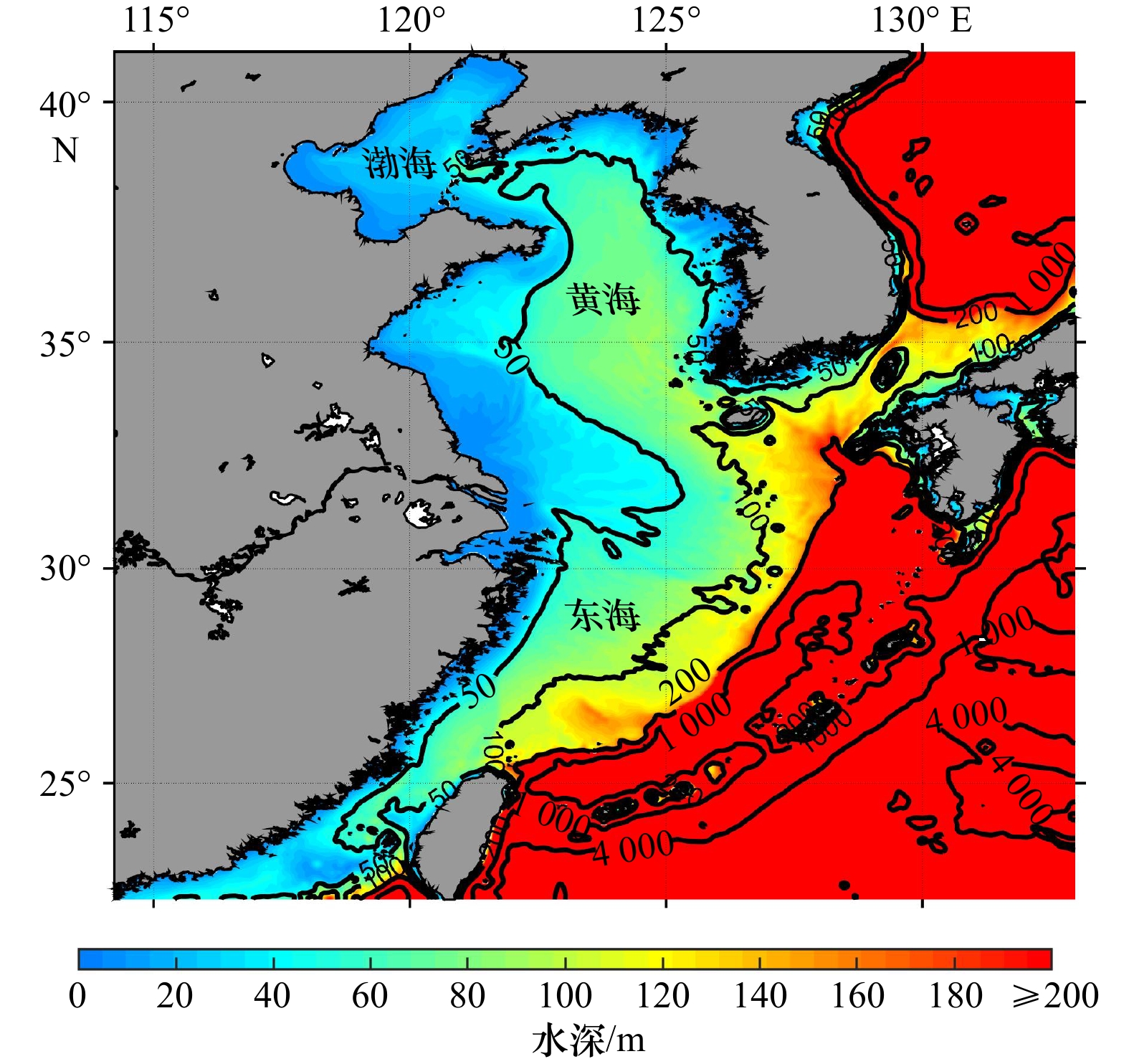
 下载:
下载:
